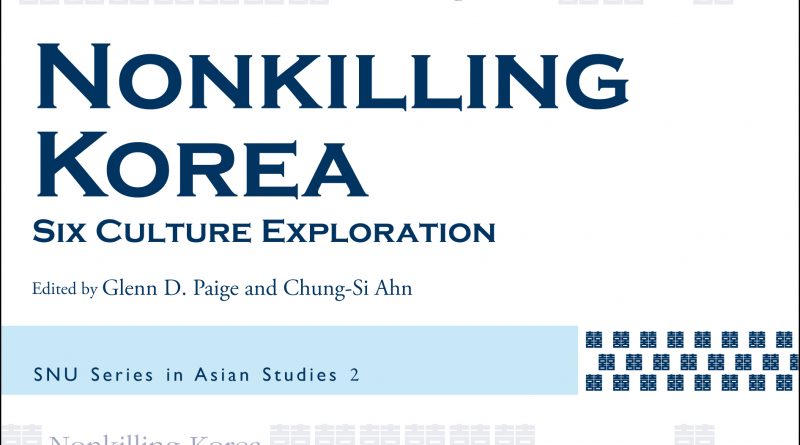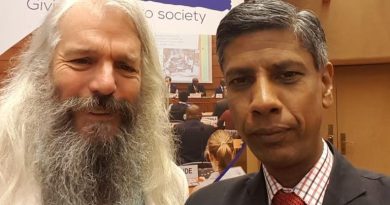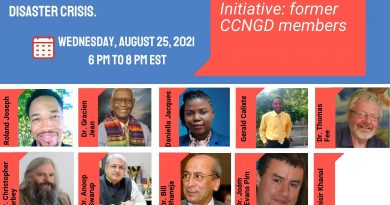Scholars’ foray to discover ‘nonkilling’ culture in Korea
(Review of Nonkilling Korea: Six Culture Exploration by Claire Lee, The Korea Herald, April 6, 2012). To those used to studying the turbulent modern Korean history, which consists of war, division and an ongoing ideological dispute, the term “nonkilling Korea” may not ring a bell at first.
But the latest book published by the Seoul National University, “Nonkilling Korea: Six Culture Exploration” is what the unfamiliar term is all about: It seeks to discover “nonkilling” or non-violent cultural values in South Korea, as well as in the U.S., China, Japan and Russia.
“Nonkilling Korea can be envisioned as a unified society in which no Koreans kill other Koreans, no foreigners kill Koreans and no Koreans are sent abroad to kill foreigners,” writes the book’s editor Glenn D. Paige.
“Society is characterized by an absence of weapons specifically designed to kill and absence of ideological justifications for killing.”
The scholarly articles featured in this book were presented during the “Nonkilling Korea: Six Culture Exploratory Seminar” which was held at the Hoam Faculty House of Seoul National University in August of 2010. During the event, each participating scholar shared their views and research findings on nonkilling customs and culture in the country of their origin.
According to the book, Koreans have suffered from killing “within and from invasion by Han Chinese, Mongols, Manchus, Japanese, Americans, Russians and others” over the centuries, while the United States have a “lethal legacy” of killing from its early history ― especially during their battles with the aboriginal peoples, the American Revolution and Civil War. Meanwhile, killing contributed to the formation of China’s current and ancient kingdoms, from the establishment of the Qin Dynasty (221- 207 B.C.) and Mao Zedong’s proclamation of the People’s Republic of China in 1949. The book also explores killings in Japan, delving into the country’s involvement in World War II, its colonization of Korea and other Asian countries in the 20th century.
In spite of the violent history of the states, however, the book offers a hopeful vision ― claiming that nonkilling states are in fact achievable. “Gandhi said in order to be nonviolent in any meaningful sense you had to be capable of violence, and renounce it,” writes Michael N. Nagler and Stephanie N. Van Hook, in their article titled “From Nonkilling to Beloved Community: Can America Help?”
“Time and time again, we have seen that the violent can undergo conversion to nonviolence by a logic that surprises the uninitiated. … School personnel have consistently found the greatest troublemakers become the best mediators.”
“What is the basis for confidence that a killing-free Korea is ultimately possible?” writes Paige. “Basic confidence resides in a simple fact. Most Koreans, Americans, Chinese, Japanese and Russians have never killed anyone. Present populations of the six cultures testify to the dominance of nonkilling over killing within them. If humans are killers by nature, parents and children would have killed each other and extinguished human life on the planet long ago.”
Among the featured articles, scholar Kang Jang-seok’s article titled “Spiritual and Practical Assets of Korean Nonviolence” offers an interesting overview on Korea’s history of nonviolence, exploring the 1919 March 1st Independence Movement, which is considered as one of the significant non-violent resistance against the Japanese. Russian scholar Tatiana Yakushkina explores the evolution of the idea of nonkilling in Russian culture, while Dahua Tang examines whether “peaceful nonkilling” China is possible.
This book is co-edited by scholars Paige and Ahn Chung-si. Paige is professor emeritus of political science at the University of Hawaii, and chair of the Center for Global Nonkilling, Honolulu, and author of “Nonkilling Global Political Science.”
Ahn currently serves as professor emeritus of political science at Seoul National University, and is the author of “Social Development and Political Violence.”.
About the book
The Center for Global Nonkilling released Nonkilling Korea: Six Culture Exploration in January 2012, which includes a selection of eight chapters from the “Nonkilling Korea: Six Culture Exploratory Seminar” convened by the Asia Center/Seoul National University and the Center for Global Nonkilling in Seoul during August 18-19, 2010. The book has been simultaneously published in two separate editions by CGNK and the Seoul National University Press. The CGNK edition can be ordered online here. The SNU Press edition can also be ordered through their website.
In contrast to academic and policy studies that concentrate on political-military-economic aspects of Korea since Division and the Korean War, authors in this book seek to discover nonkilling cultural features in South and North Korea, America, China, Japan, and Russia that can contribute to realization of a unified Nonkilling Korea – A Korea in which no Koreans kill other Koreans, no foreigners kill Koreans, and no Koreans are sent abroad to kill. Discoveries reported here provide confidence that nonkilling cultural values and capabilities can be found in all six societies that can benefit each and all in progress toward the measurable goal of a killing-free Korea and world. Readers are invited to join in further explorations.
The book is edited by Glenn D. Paige and Chung-Si Ahn, and includes a Foreword by former ROK ambassador to the United States Professor Sung Chul Yang. Contents include: “Introduction” by Glenn D. Paige; “Spiritual and Practical Assets of Korean Nonviolence” by Jang-seok Kang; “Nonkilling in North Korean Culture” by Glenn D. Paige; “From Nonkilling to Beloved Community” by Michael N. Nagler and Stephanie N. Van Hook; “Possibilities of a Peaceful Nonkilling China” by Dahua Tang; “Nonkilling in Japanese Culture” by Mitsuo Okamoto and Tamayo Okamoto; “Evolution of the Idea of Nonkilling in Russian Culture” by Tatiana Yakushkina; “Nonkilling in Russian Culture” by William V. Smirnov and “Conclusion” by the editors.




